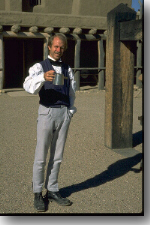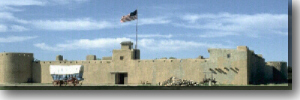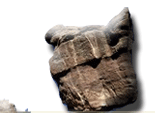BENT'S OLD FORT NATIONAL
|
|
|
| Bent's Old Fort National Historic Site. A reconstruction of the original fort, this is probably the best place in the country to learn about the Santa Fe Trail and the opening of the West. |
"A Bic lighter would be faster," I offer, garnering some chuckles from the mesmerized group watching the ancient process.
"I don't know him," replies the blacksmith, gently reminding me that in the smithy the time is the 1830s and not 160 years later."
The smithy is the heart of the Bent's Old Fort National Historic Site, a reconstructed adobe trading fort on the banks of the Arkansas River six miles east of the Colorado prairie town of La Junta. Like a time machine, it transports visitors to the 1830s, to Santa Fe Trail days, to a world of mountain men and pioneers and the vast empire of Bent, St. Vrain & Company.
Where the Santa Fe Trail and several other trading routes came together like an intersection of Interstate highways, Bent?s Fort sat in the middle of the high volume frontier traffic of traders, trappers, prospectors, and armies. As a living history interpreter put it,
"It was like putting in a gas station at a vacant intersection."
Bent, St. Vrain & Company existed only 16 years. In that short time, the company created a
trading empire that extended into nine present-day states. As the power hub of a vast area, the Company played a pivotal role in the westward movement, and even managed something that was apparently beyond the ken of the U. S. government -- it negotiated fair treaties between the Indians and whites that assured peace in the area for years.

A living history interpreter portrays William Bent, the fort's founder.
Matthew C. Field, a visitor in 1840, described the Fort as "... constructedwith all the defensive capacities of a complete fortification.... The dwellings, the kitchens, the arrangements for comfort are all such as to strike the wanderer with the liveliest surprise, as though an 'air-built castle' had dropped to earth before him in the midst of the vast desert."
The park was designed to give visitors the same feeling that Field had. The reconstructed fort sits about a quarter mile from the entrance station at the Bent's Old Fort National Historic Site, and the path from the entrance station follows the original Santa Fe Trail.
You can tour the Fort, view a video of its history, and watch living history interpreters dressed in period costume perform the tasks typical of the era in two to three hours.
Bent's Old Fort National Historic Site is on Colorado Highway 194, 6 miles east of La Junta and 13 miles west of Las Animas, both cities on US Highway 50. La Junta is about 80miles east of Pueblo, Colorado and about 140 miles west of Garden City, Kansas, on US 50. The easiest way to find the Fort is from La Junta, where you are guided by signs from US 50. Admission is $2 per person, under 17 free. Special events are scheduled several times through the year. Write the superintendent at 35110 Highway 194 East, La Junta CO 81050-9523 or call (719) 384-2596.
Other attractions in the area include the Koshare Indian Kiva, 18th St and Santa Fe Ave, La Junta. A museum of Indian artifacts and art, with a Kiva based on southwestern Indian kivas. The Koshare Indian Dancers, a nationally recognized group of Explorer Scouts whose objective is to help preserve Indian culture, perform Indian dances in the Kiva on Saturday nights in the summer. Admission to the museum is $2, $1 seniors and under 17. Dance performances are $4, $2 under 17. Phone (719) 384-4411.
Copyright 1997 by David H. Neal




